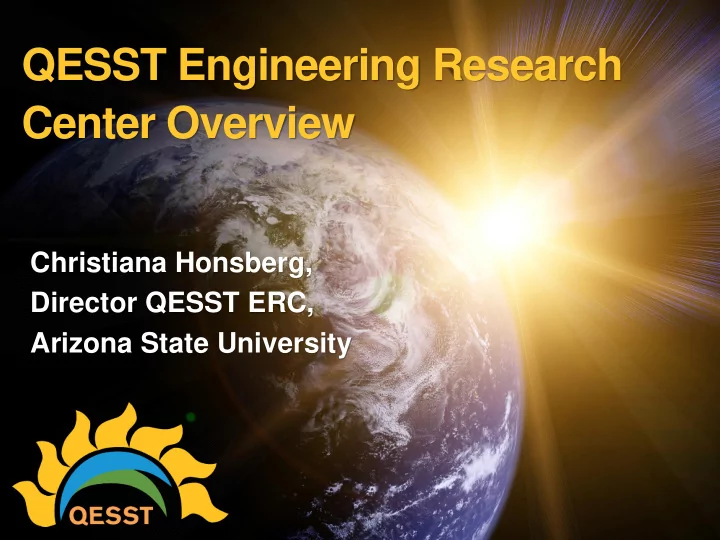

QESST Engineering Research Center Overview Christiana Honsberg, Director QESST ERC, Arizona State University
QESST Partners
International Partners
ASU & Solar Power Laboratories Clean room 10/100/1000 with 40,000 sf of space for University- Industry collaboration. Solar Power Laboratories 5,000 sf Full wafer size pilot line; III-V growth; characterization; module fab 20 MW PV installations 4
QESST Strategic Plan Ensure that solar energy continues on a path of continuous cost and efficiency improvements to meet the Terawatt Challenge through development of technologies to harvest sustainable electricity, revitalization of STEM education, and reinvigoration of the US-based PV industry
Temperature keeps rising In the US, July 2012 was the hottest month on record. In the US, 2012 was the hottest year on record. http://www.nytimes.com/2013/01/09/science/earth/2012-was-hottest-year-ever- in-us.html Australia just started using a new color of purple as the temperatures are off the charts.
Motivation Quantum devices are a disruptive technology Thermodynamically, quantum energy conversion systems have different efficiencies, properties, and how implemented and used Broad goal is to exploit advantages of “quantum” energy conversion to address the Terawatt Challenge
Growth, learning curves and impact PV, like many other semiconductor or “quantum” based technologies has experienced rapid, sustained growth. Continued growth allows PV to have major impact on Terawatt Challenge
Sustained Growth of PV Promote growth by addressing experience curve barriers Growth rates historically driven by economies of scale
Engineered System
Research Themes & Projects Engineered system and three-plane diagram defines system, technologies, and issues Research themes represent areas of key competencies which allow QESST to make substantial advances
Silicon Solar Cells: Moore’s Law Analog Higher efficiency and lower cost realized by thinner solar cells Diffused junction present multiple 32 barriers to 0 30 higher efficiency 28 1 photovoltaics 26 Efficiency (%) 10 Carrier selective 24 contacts allow 22 100 500 20 thermodynamic 18 efficiencies, 16 simple processing 1 10 100 1000 cell thickness (µm) 12
Existing and Target Silicon Solar Cells Area (cm 2 ) J sc (mA/cm 2 ) V oc (mV) FF (%) Efficiency (%) S-Q 875 87.1 43.8 33.4 UNSW 4 706 82.8 42.7 25.0 Panasonic 101.8 750 83.2 39.5 24.7 SunPower 155.1 721 82.9 40.5 24.2 ASU Target 100 785 83 42 27 Highest V oc to date was achieved with carrier-selective contacts; concept can be pushed to the S-Q limit Advanced light trapping will replace thick wafers 13
Silicon Single Junction Solar Cells Silicon solar cell path to 40% – Carrier selective contacts – Auger limits – Hot carrier effects – Limited acceptance angle – Novel light trapping
Carrier-Selective Contacts Carrier-selective contacts enable ideal V OC CSC approach comes from thermodynamic limits and detailed balance aSi/cSi is a close approximation to CSC 15
aSi/cSi Heterostructure 16
V OC > 750 mV Heterostructure Surface recombination velocity of 2 cm /s on 50 µm thin wafer . J 0 of surfaces is 1-2 fA/cm 2. Completed solar cell with ITO on both sides Voc = 753.2 mV 17
Transport at interface Transport at interface involves tunneling, transport over barrier, conventional drift diffusion Hot carrier transport aids transport over the barrier extracting 300 meV
Optical Approaches Angular control allows higher than accepted thermodynamic limits 19
Patterned silicon Ar 2 /CHF 3 SiO 2 Etching Si Etching Cl 2 Etching (Si-nanopillar) 2 SF 6 Etching Si/SiO2 Etching Sharpening tip
Surface Control with SNS Lithography 21
Uniform monolayer from center to edge ① ② ③ w/ 4-inch silicon substrate ① ② ③
Advanced Concepts in Si MEG with non-idealities in silicon
Potential Induced Degradation (PID) 0.18 0.16 Test condition 0.14 – 85 C/0% Rel. Humidity 0.12 Current (A) 0.1 initial – Negative bias (-600V) 4-hr 0.08 28-hr – Duration: 56 hours 0.06 52-hr 0.04 0.02 0 0 2 4 6 8 10 12 Voltage (V)
Baseline Process Wafer Implementation of a ‘standard’ screen print process that we can Texturing add on to for each user. Cleaning Phosphorus Diffusion Cleaning Silicon Nitride Screen Print Back Screen Print Front Fire in Belt Furnace
Line Development: Efficiency
Central goals of QESST Simultaneously increase efficiency and reduce costs – Commercial solar cells at laboratory efficiencies: silicon, thin film – Increase commercial efficiencies to SQ limit – New approaches to higher efficiency modules and cells • Low cost tandems (Si-III-V, tandem thin films) • Low X spectral splitting Sustainability TW scale manufacturing; scalable, commercially compatible manufacturing Synergistic module approaches; integrated power electronics and optics Education training of workforce
QESST Interactions
Example QESST Interactions
Example QESST Interactions V oc = 743 mV Current (arb.) 1 0 0 mV 100 200 300 320 340 360 380 390 mV
Research Highlight Exceeding Previous Limits for Doping of Gallium Nitride Demonstrated extremely high-hole concentrations in gallium nitride (GaN) and indium gallium nitride (InGaN), Work surpasses previously accepted limits to carrier concentration for this material Resistivity as a function of temperature for p- system. type GaN films is shown in black prior to the current work and shows a 150x increase in More than 50% of the magnesium resistivity due to carrier freeze-out as the is active, compared to the 1-5% temperature is decreased to 80K. The blue activation in traditional layers. line shows the results from this current work where a high-hole concentration p type GaN film grown at Georgia Tech with the resistivity is relatively unchanged at lower temperatures.
Solar Decathlon
Education 19 Courses on PV and Sustainability www.pveducation.org Individual projects
Thank you. 35
Recommend
More recommend